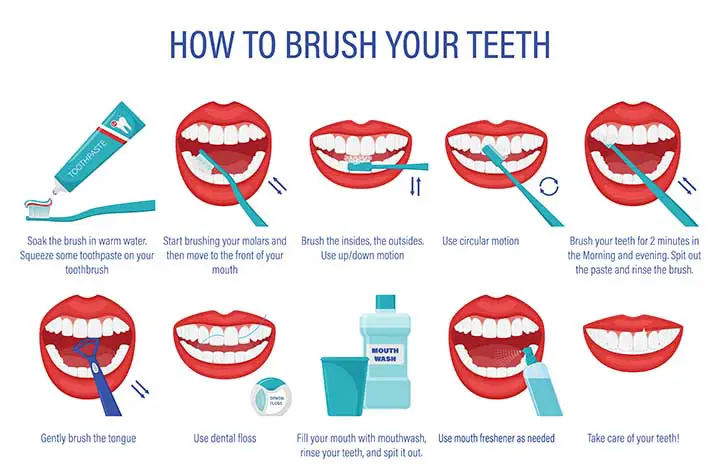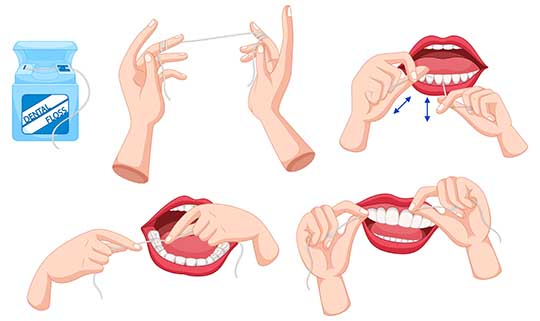Table of Contents
Teeth Cleaning Overview
Many people simply refuse their teeth cleaning. It’s easy to understand their concern, given the prodding, strange noises, and infrequent jaw discomfort. However, for the majority of people, dental cleaning is straightforward and pain-free.
Understanding exactly what is going on throughout the process can help relieve stress and allow you to enjoy the minty-fresh results to the maximum potential.
It’s also important to know what’s going on during the teeth cleaning process for better understanding what is doctor telling you. Otherwise, the doctor will brief you if you have any conditions, but you cannot understand most of them.
Routine Dental Cleaning
This is the kind of cleaning you will receive when you go to a dental clinic or dentist for your six-month checkup. Your dentist will use special tools to remove sticky plaque and hard tartar deposits from the surfaces of your teeth above your gums during routine dental cleaning. These cleanings are important for reducing gum disease and even treating mild cases of the disease (called gingivitis).
Routine cleanings are also a good time to ask your dentist about areas of your mouth where your brushing and flossing routines could use some assistance, and your dentist can also ensure you’re performing both tasks correctly so you’re removing as much plaque and tartar as possible during your home routine. Having your teeth cleaned every six months not only prevents gum disease but also helps keep bad breath at bay. Routine cleanings are typically combined with a regular checkup to allow the dentist to examine your teeth, perform an oral cancer screening, and, if necessary, take X-rays.
Deep Dental Cleaning
Deep dental cleanings, as the name suggests, clean your teeth thoroughly, using particular techniques to remove plaque, tartar, and bacteria below the gum line and all the way to the floor to your tooth roots. The bacteria that cause gum disease prefer to hide in hard tartar deposits on the gum-protected surfaces of your teeth. Toxins are released by bacteria as they multiply and thrive, irritating your gums.
Your gums begin to pull away from the floors of your teeth over time, forming tiny pockets that allow bacteria to relocate all the way down to the roots. Infections in the lower portion of your tooth can weaken the roots, causing your teeth to fall out. In fact, gum disease remains the major cause of tooth loss in adults in the United States.
Deep dental cleaning gently removes bacteria underneath the gum line and around the roots, preventing gum disease from progressing and resulting in tooth loss. In addition, your dentist will smooth (or plane) the surfaces of your tooth roots to make it more difficult for bacteria to “stick” to them in the years ahead. To kill hard-to-reach germs, an antibiotic gel can sometimes be applied to the teeth during cleaning; other times, oral antibiotics or a special antibiotic mouth rinse may be recommended. Deep dental cleaning uses local anesthetics to numb your gums as it goes below your gum line. If your gums are quite sensitive or you’re anxious, sedation may be used to keep you calm and relaxed.
Related Article – Dental Surgery | Root Canal
Steps of Teeth Cleaning
There are some steps or procedures that are being followed by a dentist while he/she cleaning your teeth.
Now, we’ll explain these steps. So that you can relate yourself whenever you are in a dental clinic or dentist’s chamber.
Physical Examination
It’s the first step of teeth cleaning.
A dental hygienist performs the majority of teeth cleanings. They begin the cleaning process with a physical examination of your entire oral cavity.
The dental hygienist examines your teeth and gums with a small mirror to look for signs of gingivitis (inflamed gums) or other possible complications.
If major issues are discovered, the dental hygienist may contact the dentist to ensure that it is safe to proceed.
Removal of Plaque And Tartar
The dental hygienist uses a scaler to remove plaque and tartar from around your gum line as well as between your teeth, using a small mirror to guide them. There will be scraping, which is normal. The more tartar there is in your mouth, the longer it will take them to scrape a specific area.

Brushing and flossing prevent plaque from accumulating and solidifying into tartar. Once tartar has formed, it can only be removed at your dentist’s chamber. So, if this is your least favorite thing of the teeth-cleaning process, the key message is to brush and floss your teeth more frequently.
Expert Electric Brushing
After your teeth have been thoroughly cleaned, the hygienist will brush them with a high-powered electric brush. which produces a grinding sound While it may sound frightening, it is a great way to get a thorough clean and remove any tartar left behind by the scaler.
Expert cleanings use toothpaste that smells, looks, and tastes like regular toothpaste, though you can often select from a variety of flavors. It does, however, have a gritty texture that gently scrubs your teeth. This tooth polishing is considered safe to do twice a year if done by a professional. However, don’t be as rough on your teeth at home, as this will wear down the enamel.
Expert Flossing
Whether you floss at home or not, none of it beats a professional flossing session. Your dental hygienist can reach deep between your teeth and identify any potential problem areas where you may bleed at the gums.
If you floss at home, this may seem unnecessary, but having a professional floss your teeth removes any leftover plaque or toothpaste from previously in the cleaning process.
Rinsing And Applying Fluoride
After that, you rinse your mouth to remove any debris. Your dental hygienist will usually give you a fluoride-containing rinse.
Fluoride care is the final step in the cleaning process. Over several months, this treatment is used as a preventative measure for your teeth to help combat cavities.
The dental hygienist may inquire as to which flavor you prefer. The foamy gel (and sometimes a sticky paste) will then be placed in a mouthpiece that fits over your teeth. It is typically applied to your teeth for one minute. Fluoride varnish is also applied to the teeth with a small brush in addition to the foamy gel. Because fluoride varnish hardens when it comes into contact with saliva, you can eat and drink right away.
Other Procedures
Professional teeth cleanings are usually done twice a year, and X-rays are done once a year. Nonetheless, obviously, it depends on what your dentist or dental hygienist sees in your mouth, they may perform additional exams during your visit. A dentist may recommend molar sealants for children to help prevent cavities in difficult-to-brush areas.
Whether you require any additional measures or not, the key is to continue visiting the dentist for regular teeth cleanings to avoid problems altogether. You’ll feel more at ease — and maybe even look forward to these consultations — if you know what’s going on ahead of time.
Read Gum Graft Surgery
Teeth Cleaning at Home
Making a habit of brushing twice a day and flossing can prevent most dental complications. So, make this a habit. Teach your children to brush their teeth twice.
Brushing
Brush your teeth with a soft-bristled brush twice a day. The shape and size of your brush should fit your mouth and allow you to easily reach all areas.
Try replacing your toothbrush every three to four months, or more frequently if the bristles are frayed. A worn toothbrush will not effectively clean your teeth.
Use fluoride toothpaste that has been approved by the American Dental Association.
How to Brush

- Brush your teeth at a 45 ° angle to the gums.
- Gently back and forth with the brush in short (tooth-wide) strokes.
- Brush the teeth’ outer surfaces, inner surfaces, and chewing surfaces.
- Tilt the brush vertically and make several up-and-down strokes to clean the inside surfaces of the front teeth.
Read Dental Prophylaxis
Flossing
There are different types of floss available. As they work differently it’s better to choose the perfect one for you.
- The Dental Tape – If you have braces, gaps, or spaces between your teeth, this type of dental floss is broader and flat like a ribbon, making it easier to handle.
- The Standard floss – This is a thin nylon strand that can be inserted between the teeth. It is available in flavored or unflavored varieties, as well as waxed or unwaxed. If your teeth are crowded or close together, wax-coated dental floss can help you get in between them.
- Super flossing – This floss threader is suitable for use with braces, bridges, and gaps. It is made up of three parts: a stiffened end for flossing beneath appliances, spongy floss for cleaning around your appliances, and regular floss for removing plaque beneath your gumline.
How to Floss

- Cut about 18 inches of floss and wrap the majority of it around one of your middle fingers. Wrap the remaining floss around the opposite hand’s same finger. As the floss has become dirty, this finger will pick it up.
- Tightly grip the floss between your thumbs and forefingers.
- Using a soft rubbing motion, lead the floss between your teeth. Never, ever snap the floss into your gums.
- Curve the floss into a C shape against one tooth once it reaches the gum line. Slide it gently into the space between the gum and the tooth.
- Maintain a firm grip on the floss against the tooth. Gently rub the side of the tooth, moving the floss up and down away from the gum. Repeat this procedure for the rest of your teeth. Don’t forget about the back of your last tooth.
Don’t use a floss twice. A used floss won’t be as effective as a new one.
Teeth Cleaning/ Dental Cleaning Summary

A tooth cleaning by a dental hygienist or other dental specialist is a 30- to 60-minute process that is necessary to keep the gums and teeth clean. Numerous people fear getting a cleaning because of dental anxieties and phobias, and they may even ignore the process entirely, which can be harmful to their teeth. Knowing exactly what to expect when having their teeth cleaned at a dentist’s office can help people have a stress-free experience.
Last Updated on February 23, 2022 by Learn From Doctor Team






